Click on images to enlarge

infestation on a creek-bank (Photo: Sheldon Navie)
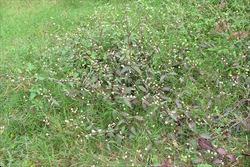
infestation in bushland (Photo: Sheldon Navie)

habit prior to flowering (Photo: Sheldon Navie)
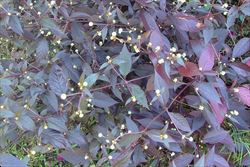
habit in flower (Photo: Sheldon Navie)

younger leaves (Photo: Sheldon Navie)

greenish-coloured leaves on a plant growing in a shady area (Photo: Sheldon Navie)

dark purplish leaves on a plant growing in a sunny area (Photo: Sheldon Navie)

upper leaves and numerous stalked flower clusters (Photo: Sheldon Navie)
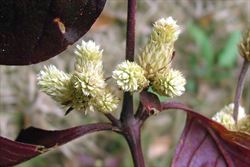
close-up of stem and whitish flower clusters (Photo: Sheldon Navie)

seedling and young plant (Photo: Sheldon Navie)

though bloodleaf (Iresine herbstii) also has similar purplish leaves, it is not very closely related to purple joyweed (Photo: Sheldon Navie)
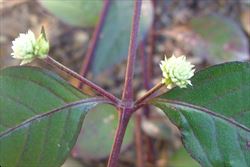
close-up of young flower clusters (Photo: Sheldon Navie)
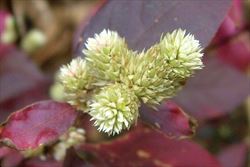
close-up of flowers and immature fruit (Photo: Sheldon Navie)
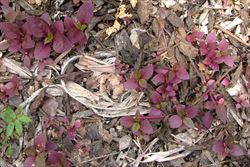
mass germination of seedlings in a garden (Photo: Sheldon Navie)

Alternanthera brasiliana 'Summer Flame' (Photo: Sheldon Navie)
Scientific Name
Alternanthera brasiliana (L.) Kuntze
Synonyms
Alternanthera brasiliana (L.) Kuntze 'Rubiginosa'
Alternanthera brasiliana (L.) Kuntze var. villosa (Moq.) Kuntze
Alternanthera dentata (Moench) Stuchlik ex R.E. Fr.
Alternanthera dentata (Moench) Stuchlik ex R.E. Fr. 'Rubiginosa'
Alternanthera dentata (Moench) Stuchlik ex R.E. Fr. 'Rubra’
Gomphrena brasiliana L.
Gomphrena dentata Moench
Telanthera brasiliana (L.) Moq. var. villosa Moq.
Family
Amaranthaceae
Common Names
alternanthera, Brazilian joyweed, calico plant, indoor clover, Joseph's coat, joy weed, large purple alternanthera, metal weed, parrot leaf, purple alternanthera, purple joy weed, purple joyweed, ruby calico plant, ruby leaf, ruby leaf alternanthera
Origin
Native to southern Mexico, Central America (i.e. Belize, Guatemala and Nicaragua), the Caribbean and tropical South America (i.e. French Guiana, Guyana, Surinam, Venezuela, Brazil, Colombia, Ecuador and eastern Peru).
Naturalised Distribution
Purple joyweed (Alternanthera brasiliana) is becoming widely naturalised in the coastal districts of northern and eastern Australia. It is relatively common in northern Queensland and the northern parts of the Northern Territory. Also naturalised in the coastal districts of central and southern Queensland and in the Kimberley region in northern Western Australia.
Naturalised overseas in south-eastern USA (i.e. Florida), South Africa and on some Pascific islands (e.g. Hawaii, Niue and Palau).
Notes
Purple joyweed (Alternanthera brasiliana) is now regarded as an environmental weed in Queensland and the Northern Territory. This species is very common in cultivation as a garden ornamental and is often grown as a hedging plant. It has escaped cultivation and become naturalised, particularly along waterways in the warmer and wetter coastal areas of northern Australia.
Several cultivars are available and these generally differ in the colour of their foliage. Alternanthera brasiliana 'Rubiginosa' (aka. Alternanthera brasiliana 'Ruby' or Alternanthera brasiliana 'Rubra') is probably the most common of these, in both cultivated and naturalised plants, and has reddish-purple coloured leaves.
Purple joyweed (Alternanthera brasiliana) appears on some environmental weed lists in eastern Queensland (e.g. in Ipswich City and Redland Shire) and is regarded as an emerging weed or "sleeper weed" in the Katherine region in the Northern Territory. It is also seen as a threat to native plant ecosystems in aboriginal lands in the Northern Land Council area.
This species is also listed as an alien invasive plant in the Kruger National Park in South Africa.

